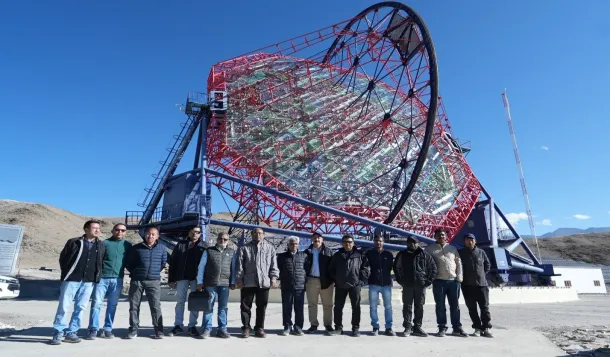Context:
Recently, the Department of Atomic Energy (DAE) inaugurated the Major Atmospheric Cherenkov Experiment (MACE) Observatory in Ladakh.
About MACE Observatory
MACE is an imaging atmospheric Cerenkov telescope (IACT) located in Hanle Dark Sky Reserve (HDSR), Ladakh, India.
- An imaging Cherenkov telescope (IACT) is a large-aperture telescope that detects gamma rays by indirectly interacting with the atmosphere.
MACE is the largest IACT in Asia. Located at an altitude of ~4,300 m, it is also the highest of its kind in the world.

The telescope is indigenously built by Bhabha Atomic Research Centre (BARC) with support from the Electronics Corporation of India Ltd (ECIL) and other Indian industry partners.
- Dr Homi J. Bhabha established the Atomic Energy Establishment, Trombay (AEET) in January 1954 for a multidisciplinary research program. After his death in 1966, AEET was renamed Bhabha Atomic Research Centre (BARC).
The MACE Telescope consists of
- A large-area tessellated light collector of 356 m², made up of 356 mirror panels.
- A high-resolution imaging camera weighing about 1200 kg, for detection and characterisation of the atmospheric Cherenkov events.
- The telescope, weighs about 180 tons and is supported on six wheels which move on a 27-metre-diameter track.
- An integrated imaging camera, which contains 1088 photo multiplier-based pixels.
Working of the MACE Telescope
- Gamma rays do not reach the Earth’s surface as they are stopped by the atmosphere.
- However, interaction with the atmosphere creates high-energy particles that travel faster than the speed of light and emit Cherenkov radiation which is akin to a sonic boom.
- The mirrors and cameras capture these flashes and trace them back to their cosmic source.
Significance of the Project
- The MACE project plays not only in advancing India’s space and cosmic-ray research capabilities but also in supporting the socio-economic development of Ladakh.
- It will observe high-energy gamma rays, contributing to global efforts to understand the most energetic phenomena in the universe, such as supernovae, black holes, and gamma-ray bursts.
- This facility will also complement global observatories, strengthening India’s position in the field of multi-messenger astronomy.
- It will also help in inspiring future generations of Indian astronomers, scientists, and engineers.

